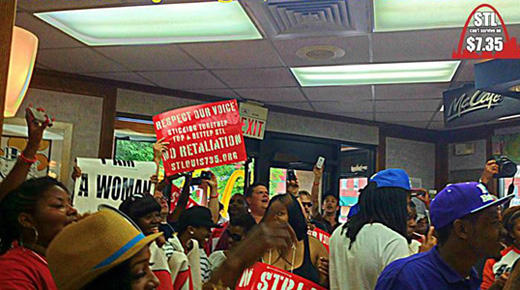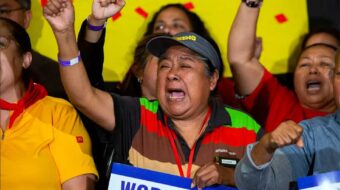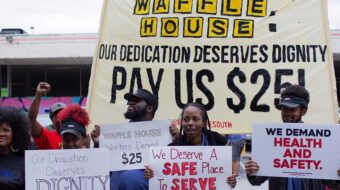
KANSAS CITY, Mo. – A recent study by a University of Kansas School of Business student, Arnobio Morelix, has challenged claims by fast-food giant McDonald’s that raising its low-paid workers’ pay is unreasonable. This People’s World reporter met with Morelix here last week to discuss his study, its methodology and the backlash he’s received since its publication.
Thousands of low-wage workers, supported by their community and labor allies, went out on strike at fast-food restaurants across the country last week. They are demanding a pay raise to $15 an hour and a union.
Corporate fast-food giants like Burger King, Wendy’s, Hardee’s, Jimmy John’s and McDonald’s claim the workers’ demands are unreasonable; that their request for $15 an hour would dramatically increase costs, cut into profits too deeply and force consumers to shop elsewhere.
McDonald’s received even more bad publicity when it published a “sample budget” for its employees, which suggests, among other things, that they work two jobs, pay only $20 a month for health insurance and NOT put gas in their car.
Needless to say, the “sample budget” caused quite a stir and added fuel to an already growing national firestorm of protests seeking to increase the minimum wage by tapping into the enormous profits of fast-food chains. McDonald’s made $1.4 billion in profits last quarter.
The study by Morelix has brought additional negative attention to the fast-food behemoth.
The study concludes that McDonald’s could “double the salaries” of its employees to $15 an hour by increasing the price of its Big Mac by 68 cents and the Dollar Menu by 17 cents.
One detractor, Ryan Chittum, of the Columbia Journalism Review, believes there are “serious problems” with Morelix’s study.
Chittum says the study uses bad math, and does not distinguish between company-operated McDonald’s restaurants and franchises. Chittum writes, “More than 80 percent of McDonald’s restaurants are franchises, and the company makes scads of money from them in no small part because it has no direct labor expense at those stores.”
In company-operated stores, Chittum argues, “a Big Mac would, in fact, have to go up by a full dollar, not 68 cents, in order to double wages at McDonald’s. And the Dollar Menu would have to become the Dollar Twenty-Five Menu.”
Morelix says he’s “surprised by the controversy,” as the model he used “is pretty basic and straightforward.”
While he acknowledges that his study has certain limitations, Morelix said the main point “is very clear, that prices would NOT double if cost [from raising wages] doubled.” He said his “whole goal” was to “clarify this one specific issue, which isn’t being discussed.”
The controversy is surprising, as even Chittum admits the Dollar Menu would only become the Dollar Twenty-Five Menu – Morelix was off by a mere 8 cents. His main point still holds. Prices would NOT double if wages were doubled, which is what McDonald’s and other forces opposed to raising the minimum wage claim.
In fact, Morelix created three different models, something Chittum ignores. The first model looks at all McDonald’s restaurants. The second looks at corporate-owned stores only. And the third is a franchise only model.
“I made a judgment call,” he said. “Given a certain set of circumstances, the model assumes profits and quantity sold would stay constant, and if so, then price would increase by 17 cents. It’s an interpretation, a hypothetical simulation under very specific circumstances, a snapshot.”
Economists generally say economic models are at best snapshots. They provide a picture with very clearly defined boundaries. This is Economics 101. Why Chittum and others seem to be going out of their way to discredit Morelix’s study is perplexing, especially as they have paid little or no attention to McDonald’s shoddy math in the corporation’s “sample budget.”
A different viewpoint was expressed by Forbes contributor Tim Worstall, who writes, “Doubling of, or a halving of, or any other change in, the wages of McDonald’s will have absolutely no effect whatsoever on the price of a Big Mac or the Dollar Menu. For prices are not set by the cost of production of something, but by the supply and demand for that item.”
If one takes Chittum’s math at face value, then it ends up adding an extra 25 cents – instead of an extra 17 cents as Morelix predicted – to the cost of the Dollar Menu. Most people would likely have no problem with that, if it ensures McDonald’s workers make a living wage.
But maybe, as Worstall writes, wages will have “absolutely no effect” on the prices, because it all depends on supply and demand.
Morelix said he isn’t too concerned about his critics. “They obviously haven’t actually read my study where I explicitly state the assumptions and limitations and also try to account for the various scenarios.”
“As long as I’ve added something to the conversation, added something to the issue, then I’m pretty happy about the outcome,” he added.
Obviously, there are a lot of different opinions on this complex subject. But one thing is certain. Morelix has done the public, and especially low-wage fast-food workers and their supporters, a huge favor. By asking a few basic economic questions, he has started a conversation. He has brought publicity to an issue that no one seemed interested in talking about a few weeks ago.
Photo: Workers take over a McDonald’s on Broadway in St. Louis. St. Louis Can’t Survive on $7.35 Facebook page.










